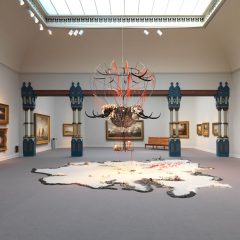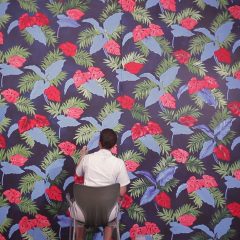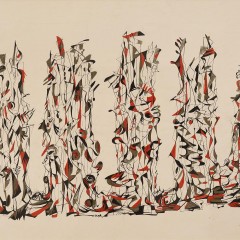I was privileged to be invited to see a wonderful and unusual private art collection in Philadelphia, and to meet with the collectors, who have graciously agreed to allow me to write this profile of them and their collection.
These individuals intend to donate their entire collection to the Pennsylvania Academy of Fine Arts (PAFA) in Philadelphia. Some time after that occurs, the collection will be exhibited there and made available to the public for the first time.
For a number of reasons, however, the collectors wish to remain anonymous at this time.
They appear here under the names George and Natalie.
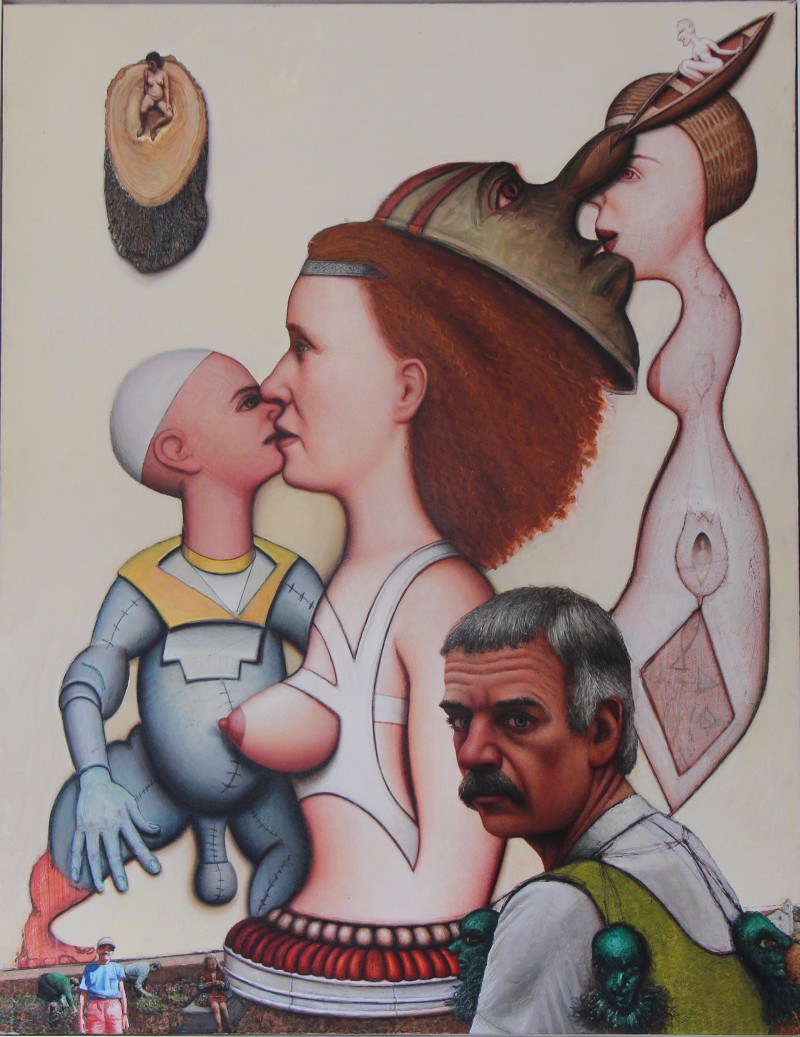
Life’s Journey
George and Natalie, both retired academics, live in a lovely old brick house on a tree-lined street in Philadelphia, where they have lived since 1973. They raised a family and assembled a remarkable art collection in the house. It is a modest, comfortable, lived-in abode that is utterly without pretension. As are they. But their collection of art – over 300 works – which populate every room in the house, is perhaps the antithesis of its reserved surroundings. It is a collection of powerful, edgy art work – they describe it as “expressive” or “passionate” figuration – by over 50 artists, some of whom have become well known, at least in certain circles, and many of whom remain unknown, marginalized, forgotten, or out of the mainstream. When I first visited them, George and Natalie walked me through the house, and they spoke with great insight and passion about the artwork they have collected and about each of their artists. It was as if we were leafing though an album of their family photographs.
George and Natalie’s journey as collectors began over 35 years ago, in the early 1980s, when they found themselves inspired by an exhibition at PAFA titled Contemporary American Realism since 1960, which was curated by Frank H. Goodyear, Jr. This exhibition included works by many prominent as well as lesser known artists, including Alice Neel, Ben Kamihira, Martha Erlebacher, Sidney Goodman, Paul Georges, Alfred Leslie, James Valerio, Catherine Murphy, Fairfield Porter, Joseph Raffael, and Jack Beal. It also included works by Gregory Gillespie and William Beckman, two artists whose work George and Natalie would go on to collect.
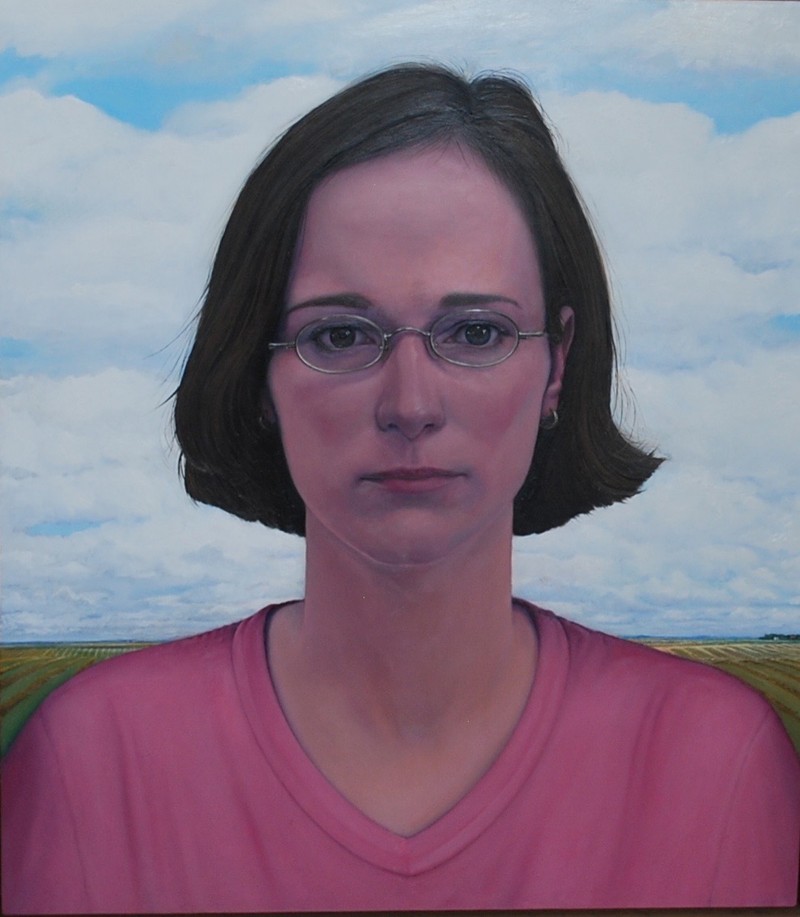
From the beginning, George and Natalie were attracted to figurative works that conveyed strong personal emotion, works about the cycles and vagaries of human life, works about “our dangerous species,” and those interests essentially defined the ensuing 35 years in which they went on to collect art. George explained: “In general we liked the safer realist ones in those early years, though not the photorealists particularly. I think even then we were drawn to the weirdish side of realism, and we moved further to the weird side fairly quickly.”
Last year, in connection with a small exhibition of works from their collection, George and Natalie described their interests as collectors as follows:
“We are drawn to human images and to scenes, remembered or imagined, that embody the felt experience of living. Self-portraits are a particular favorite, and pictures of people who have in some way aroused our artists’ deepest feelings. In some of these works, the artist captures feelings with intense, almost surreal, obsession with detail; in others, with rough and spontaneous gesture. Ours is not the pure ideal of art for art’s sake, but the highly impure one of art from and for life. Many of the works that we have acquired concern “life’s journey.” The subjects covered include birth and childhood; parents and family; maturity, with its choices and worldly achievements and failures; and decline and death. We did not set out to collect around these themes; we simply discovered, by looking and learning, what engaged our feelings and what we wanted to live with all day every day. Some visitors to our house wonder how we can live in such a diversely peopled and visually charged company; we wonder how we could live without it.”
The emphasis is mine.
Indeed, a walk through George and Natalie’s collection is an experience to remember. I used the word ‘edgy’ earlier, and that it is. So much of the work they have collected is fierce, raw, and disturbing. It bespeaks conflict and division, ambivalence. It is quirky, weird, and sexy. Things are not always what they appear to be because in these narrative works, the storytelling is often elliptical and metaphorical.
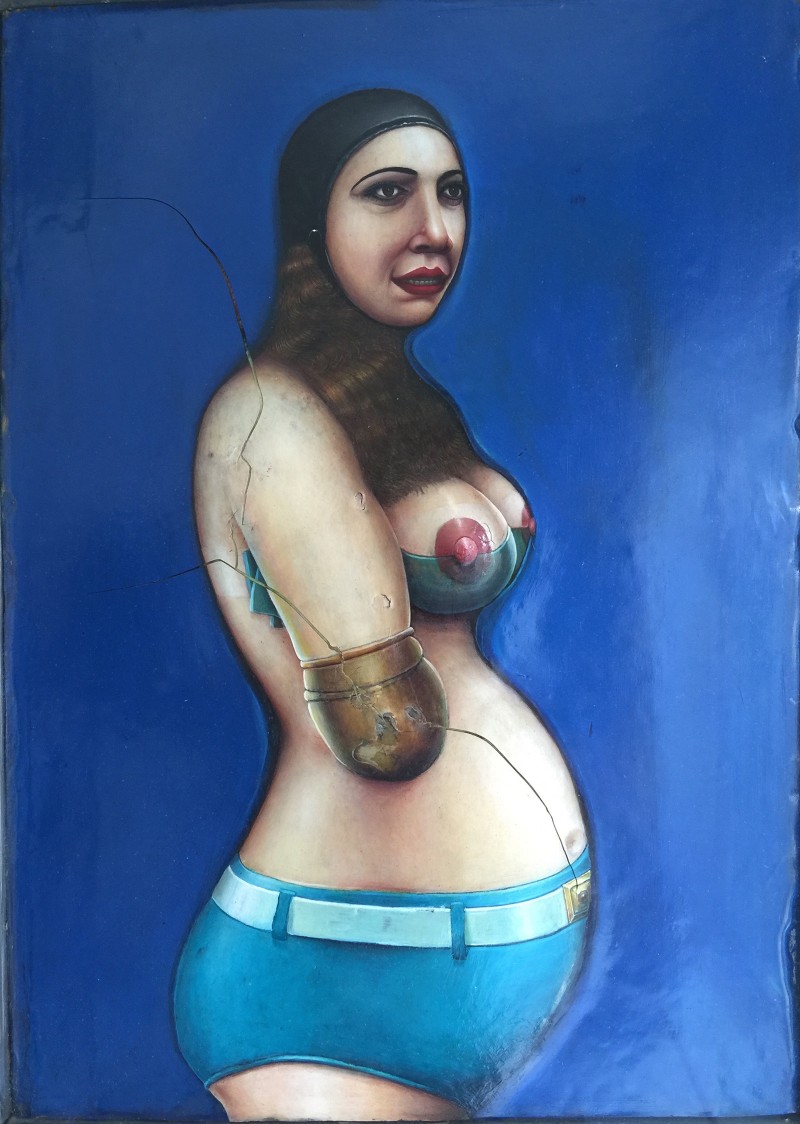
I wrote a note to George when I was writing this article and asked him what he thought about including an image of a drawing in his collection that I was afraid would make some people uncomfortable because of its unusual and explicit sexual content. George’s response was that there is nothing that the artist in question has created that the public should not see.
I asked a number of individuals associated with PAFA for comments about George and Natalie’s collection. Jodi Throckmorton, PAFA’s Curator of Contemporary Art, described them as adventurous and passionate collectors: “They’re not interested in telling the story that everyone has heard – they’re dedicated to marginalized artists that deserve greater attention. It’s bold to collect like this.”
Harry Philbrick, formerly PAFA’s Edna S. Tuttleman Director of the Museum, spoke about the thoughtfulness and independence that have defined George and Natalie’s collecting. He added: “[Their] devotion to exploring alternative narratives in recent art history, and their deeply empathetic response to artists outside the mainstream, are buoyed by their intelligence, restless curiosity, and thoughtful contemplation of the hows and whys of particular artworks.”
Bob Cozzolino, the former Senior Curator and Evelyn and Will Kaplan Curator of Modern Art at PAFA, now the Patrick and Aimee Butler Curator of Modern Art at The Minneapolis Institute of Arts, commented:
“[George and Natalie] have quietly built a collection that is personal, bears their identity, shows empathy and risk, is daring and full of surprises. Their choices reveal that they care about not only the way artists make things but how they feel and how the way things are made carry the weight of their subjects. What I have loved is that they are the rare collectors that gravitate towards challenging subject matter – artists working out their demons, wrestling with intimacy, looking into the void. A great deal of the work reveals artists confronting themselves at vulnerable moments in life, or exposing their deepest fears or ecstatic joys.”
Ms. Throckmorton also pointed out that George and Natalie’s collection “connects key art movements from Chicago, California, New York, and Philadelphia.” And Bob Cozzolino noted that they have collected “off the beaten path based on what they love and believe in rather than listening to the market or ‘experts.’ This has kept the collection honest, and it is also regionally diverse. It is strong on Chicago, the San Francisco Bay Area, and a Massachusetts group (around Gregory Gillespie): this is a rarity on the East Coast. They have also collected in a way that favors women artists, naturally and organically. They have supported artists beyond mid-career when the art world usually abandons them.”
The Fate of the Collection
As I noted above, George and Natalie intend to donate their entire art collection to PAFA. When I asked them about this, they explained that because they view the collection as an entity greater than its components – and of course it is an entity that is still growing and developing – they want it to remain intact and preserved. The thought of the collection being dismembered at auction is intolerable to them. When PAFA receives the collection, George and Natalie expect that PAFA will display it in its entirety in what is bound to be a monumental exhibition.
George and Natalie chose PAFA because it is a relatively small institution and because they believe that PAFA shares their curatorial vision, their commitment not simply to quality, but to quality in a diverse group of artists not always recognized in the mainstream. They spoke with admiration and enormous respect for former PAFA curator Cozzolino, who has been known as the “curator of the dispossessed.”
Harry Philbrick pointed out to me that “[George and Natalie] are uniquely generous in their collecting, transforming what had been a quite private endeavor into something that will benefit PAFA, and Philadelphia, for perpetuity.” Jodi Throckmorton remarked that “their approach and generosity of spirit will have a significant impact on how alternative art historical narratives are included in the larger discourse on American art.”
Still, there is something sad, albeit inevitable, about the fact that ultimately George and Natalie’s collection will essentially reside in PAFA’s storage vault. But what is the alternative, particularly if it is the desire of the collectors to keep their collection intact? This, in any case, is the fate of much, if not most of the better art work that has ever been created, and that ever will be created. A large part, even the majority, of the collections of most major museums is held in storage and generally inaccessible to the public. See, for example, “Museums are keeping a ton of the world’s most famous art locked away in storage,” Quartz.
Digital archiving and virtual touring, in addition to old-fashioned publishing, do play a part in alleviating this grim reality. But of course there is a vast difference between experiencing a work of art in person and being presented with it in any other medium. The reality is that at the end of the day, given the vast universe of art, no one can expect ever to have personally experienced but a small fraction of that ever-expanding world. I don’t know if we can ask for more.
Notes About The Artists
Because of the sheer magnitude of George and Natalie’s collection, it is not possible for me to highlight more than a fraction of its contents. I have therefore chosen to focus upon a selection of the work that stood out to me, which includes a number of the more well-known artists they have collected, and some of the least well-known. In any case, the works addressed and displayed here are intended to provide a glimpse of the character of the collection as a whole.
Gregory Gillespie
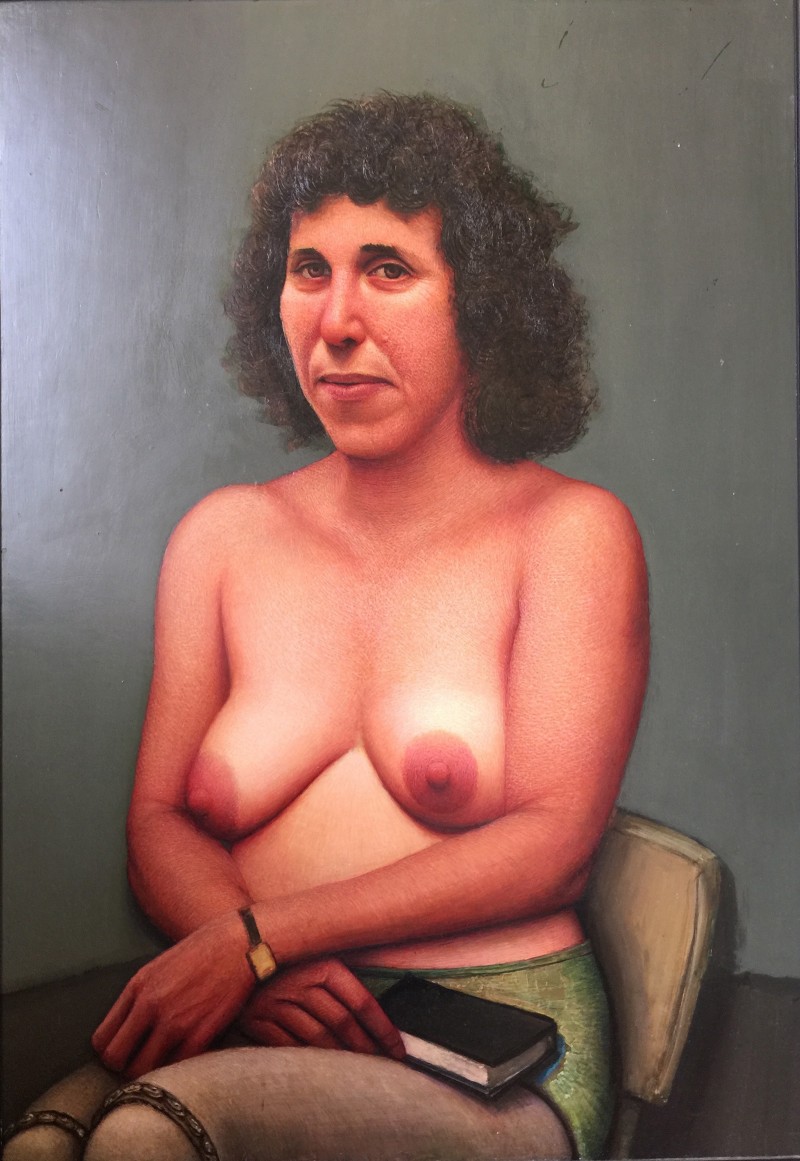
As I noted above, Gregory Gillespie was one of the artists whom George and Natalie were introduced to at PAFA’s Contemporary American Realism exhibit, and one of the first artists whose work they decided to collect in depth. They have since acquired many of his works. When you walk into their house, Gillespie’s “Self-Portrait with Mother and Son,” pictured at the beginning of this article, is one of the first pieces that greets you. Gillespie lived in New England until 2000 when, at age 64, he took his own life. A master, among other things, of unusual, unexpected, intense portraits and self-portraits, many of which strain realism to its psychological limits, Gillespie, although clearly an outlier in the art world, is far better known than many of the artists in George and Natalie’s collection. His work was exhibited widely during his lifetime, and it also appeared in another PAFA exhibition, Narcissus in the Studio: Artist Portraits and Self-Portraits, at the end of 2010, which was curated by Bob Cozzolino. I have also included here images of Gillespie’s “Woman on Blue Ground,” pictured above, and his portrait of his second wife, “Peggy.” When George showed me “Peggy,” he used the word “ambivalent” to describe the portrait; he also noted that it was that ambivalence that had attracted him and Natalie to the painting.
John Thornton, a documentary film maker who works out of Ocean City, New Jersey, recently produced an excellent video about Gillespie: “Underneath: The Life and Art of Gregory Gillespie.” The documentary can be viewed on YouTube.
William Beckman
George and Natalie have also collected the work of William Beckman, another relatively well-known artist and a contemporary and friend of Gregory Gillespie. Beckman’s work also appeared in PAFA’s Contemporary American Realism and in Narcissus in the Studio. In fact, Beckman and Gillespie painted a number of impassioned portraits of each other. Beckman’s brilliant portrait of his daughter, “Diedra,” is included above.
Jane Lund
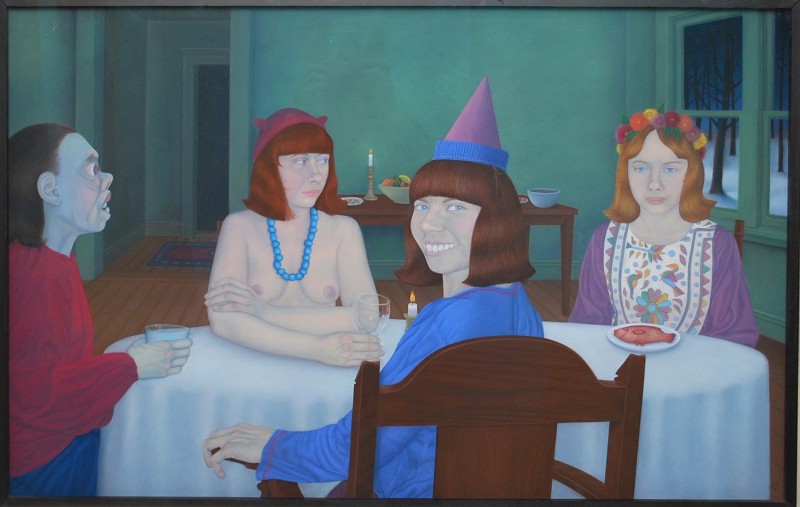
Lund is another New Englander and friend of Gregory Gillespie. I have included here an image of her “Party for Myself.” George and Natalie were drawn to Lund’s extraordinary pastels, in which she works through dramatic turns in her life’s journey with a visual, almost hallucinatory clarity. They saw “Party for Myself” – which strikes me as Lund’s autobiographical dream, a psychological exploration of four complicated versions of herself – in a gallery on a visit to Boston in the early years of their collecting, and they hated it. On the drive back home, however, they realized that they loved it, and once back home immediately called the gallery and acquired it. Natalie told me that she saw in the painting four similar sides of her own personality: the shy good girl, the sexpot, the gorgon, and the idiot trying to please. Lund became a favorite of theirs.
Anne Kraus
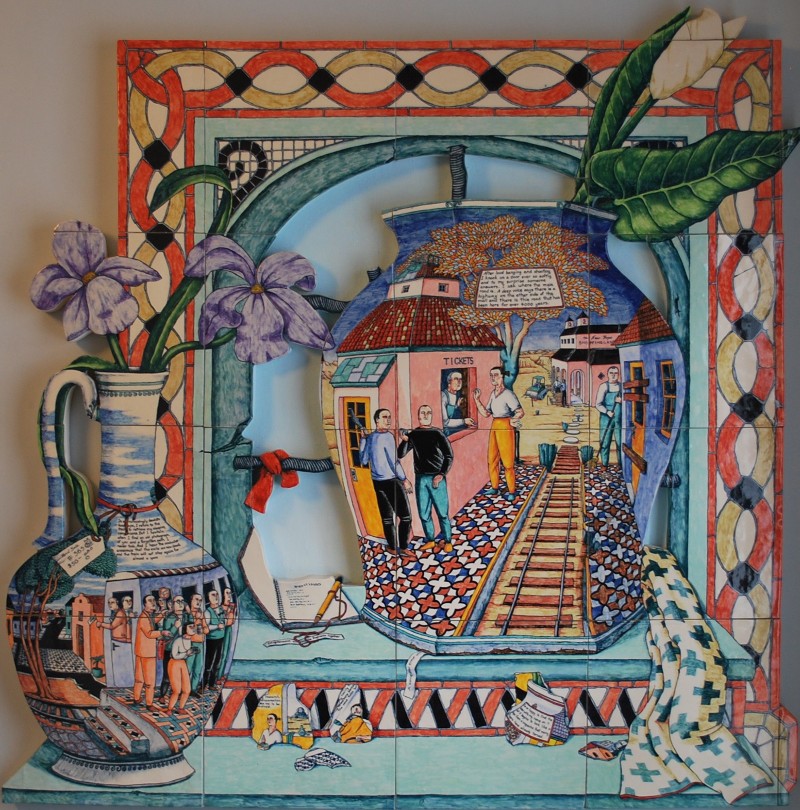
Another artist who captured George and Natalie’s attention was Anne Kraus, a ceramicist who worked in Colorado. She died in 2003. Kraus depicts evocative, disturbing scenes that include dreamy, mysterious narratives about travels in space and time, about cracks in the universe that we tend to overlook despite their appearance before us. Among the tiled, narrative pieces in their collection is “New Hope Shopping Land,” pictured above. The text on the vase in “New Hope” reads: “In an increasingly desolate landscape, I return to the train to retrieve my sleeping companions. But I hesitate when I find an old photograph of you and a forgotten path I never took. And I hear the conductor announce that the exits are now closed and the train will not stop again for almost a year.”
Robert Lostutter
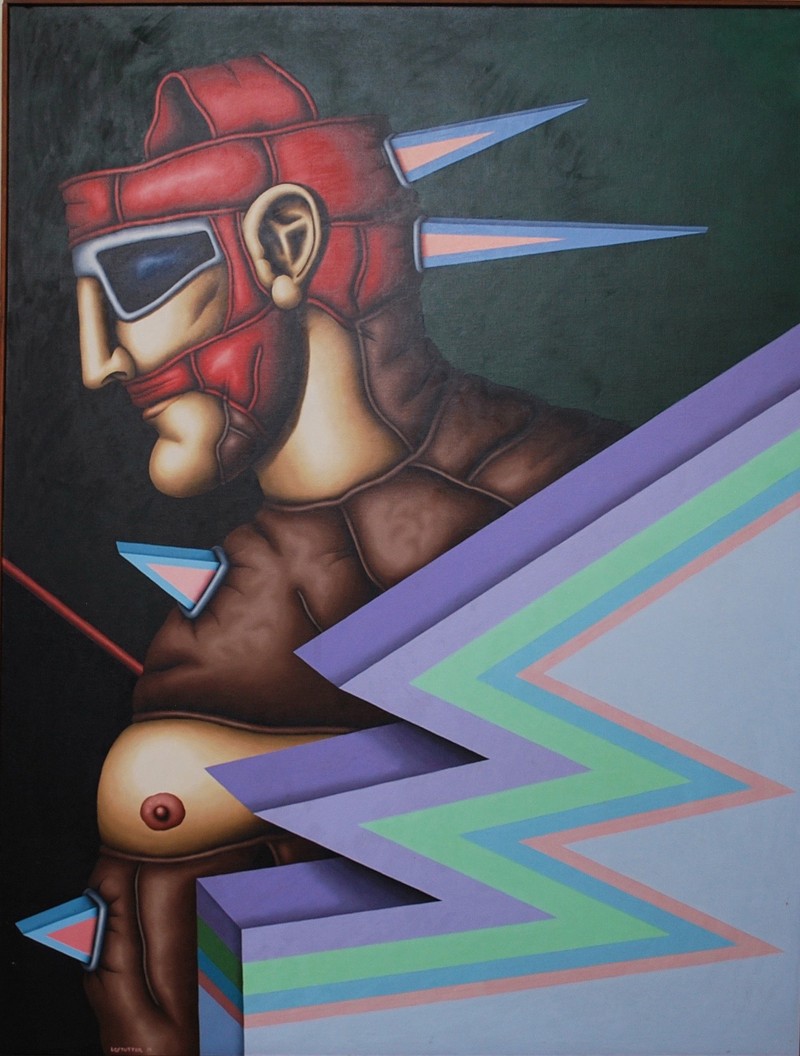
Lostutter, a contemporary of the Chicago Imagists (though less well known), captivated George and Natalie, and they have collected a number of his works. His “Untitled,” included here, I think perfectly captures their eccentric sensibilities – and his. The leather-bound male figure in the painting is powerful and aggressive, but his flesh tones are warm and his exposed female breast (with a misplaced nipple) is soft. He moves behind a jagged wall, and spikes erupt from his body, but the design of the wall and the spikes looks almost like a decorative pastel textile from the 1950s. The effect is unusual and spellbinding.
Rafael Ferrer
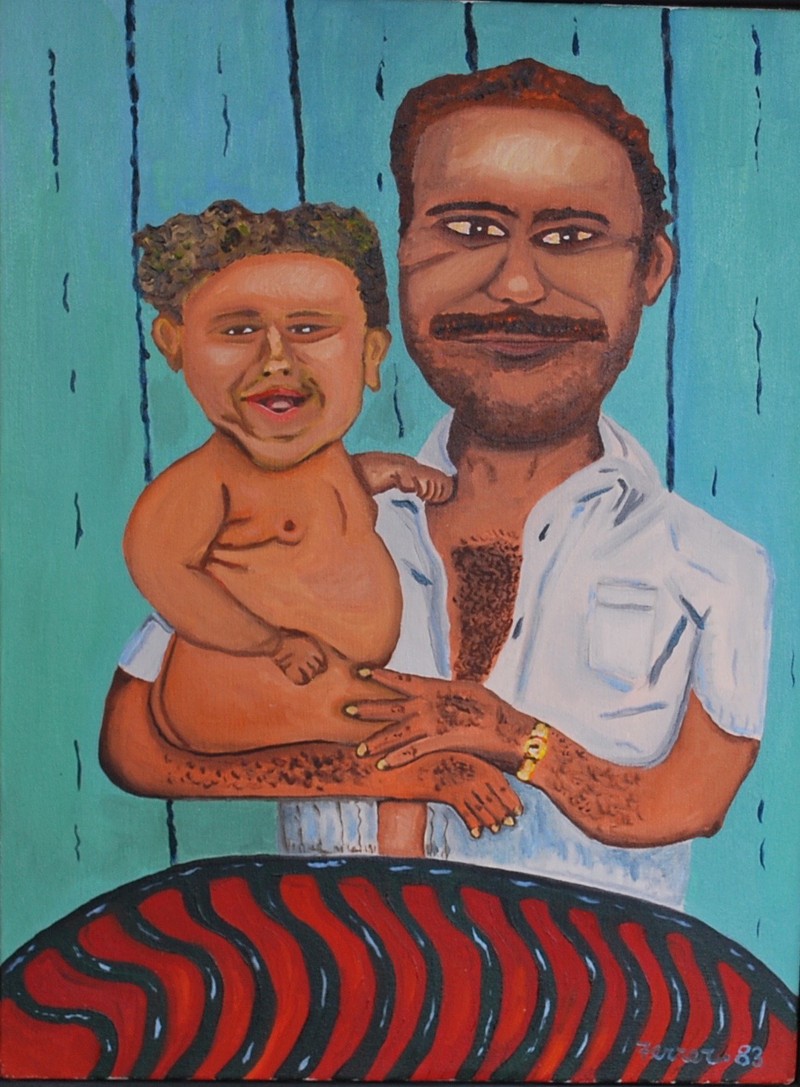
George and Natalie have collected a number of the works of this New York painter with roots in Puerto Rico and Philadelphia. They found themselves drawn to the “lush, lovingly depicted paintings of his experience of the places and varied lives of the Caribbean islands and islanders – like this tender portrait of a proud father and his little son,” pictured here.
Tabitha Vevers
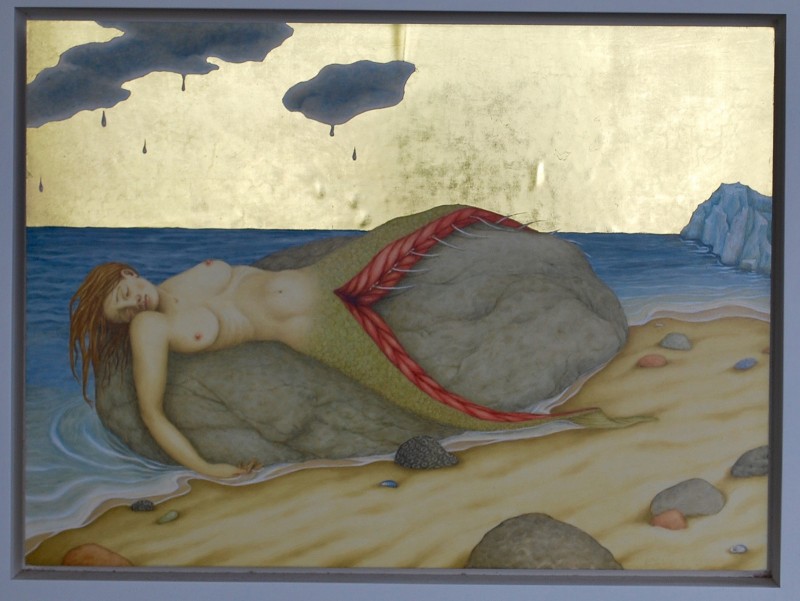
Vevers, another New Englander, plays a prominent role in the collection. Her work is intensely personal and often reflects upon human sexuality, and on our heedless destruction of our sustaining global environment. I have included here an image of her “When We Talk of Rape IV,” a powerfully dramatic piece which viscerally evokes the feeling of being raped. In her work, Vevers reflects upon what we leave behind when we pillage the blessings that have been conferred upon us.
Eric Stotic
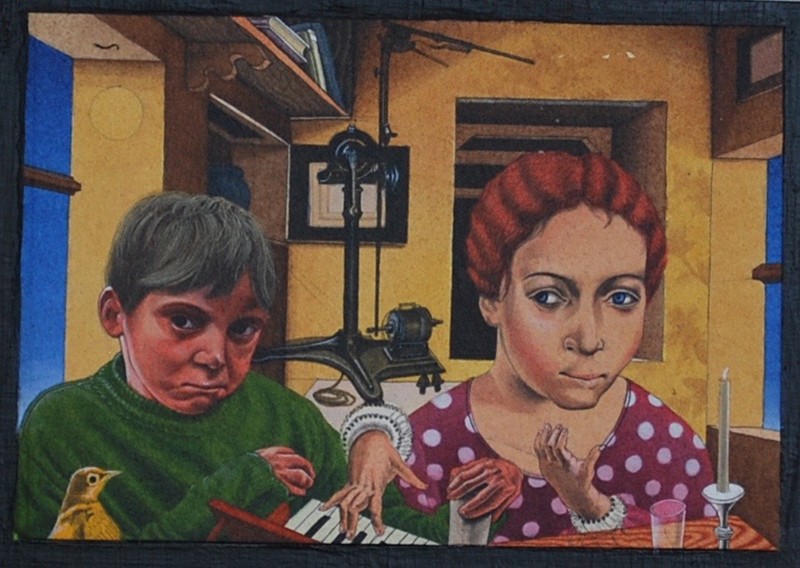
George and Natalie have collected a number of pieces by this Portland, Oregon, artist who grew up a child of missionaries in Papua New Guinea and Melbourne, Australia. They have been attracted to the sense of dislocation in his work, and to his focus upon the terrors and mysteries that can infect family relations, as evidenced in his “Untitled,” pictured here.
Deborah Kravitz
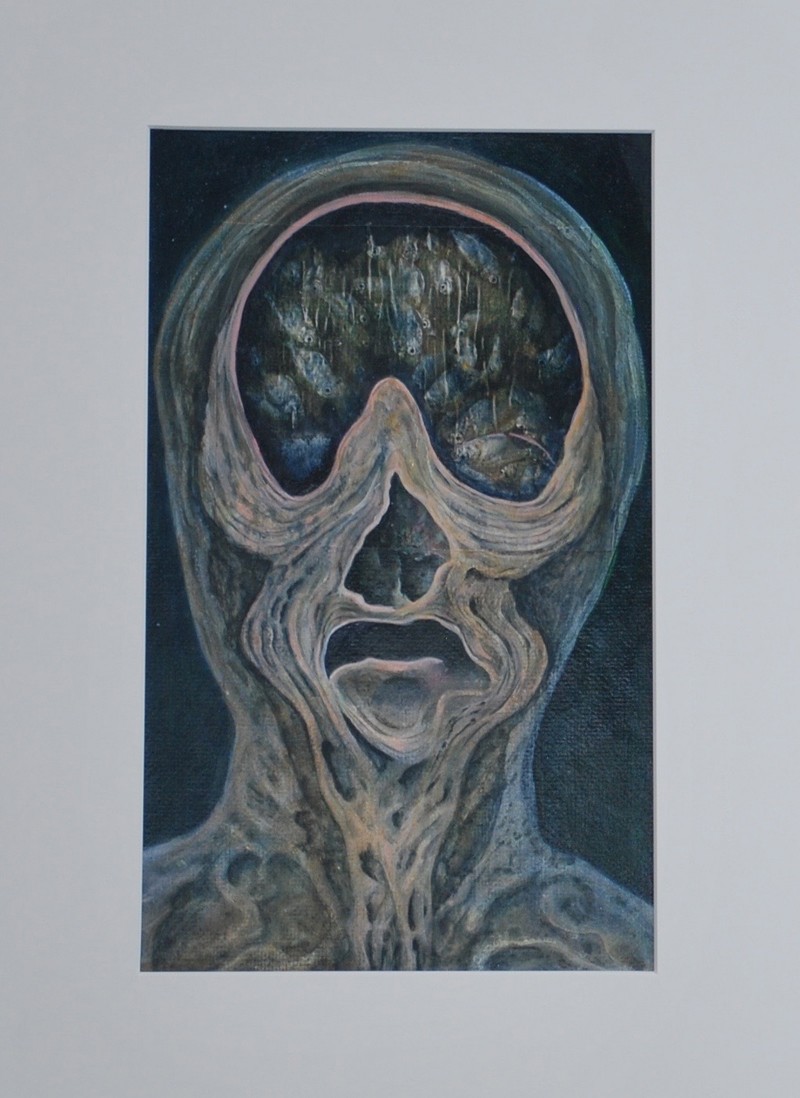
George and Natalie have an extensive collection of the work of this New England artist. Kravitz grew up in a politically progressive but troubled family and, in George and Natalie’s words, she has used art as “a means of coming to terms with disturbing issues of personal identity and family relationships, transforming painful experiences into strikingly personal depictions of universal issues in life’s mixed journey.” Her severe “Self-Portrait with Piranah,” a collage pictured here, is a haunting example of her work.
Gladys Nilsson
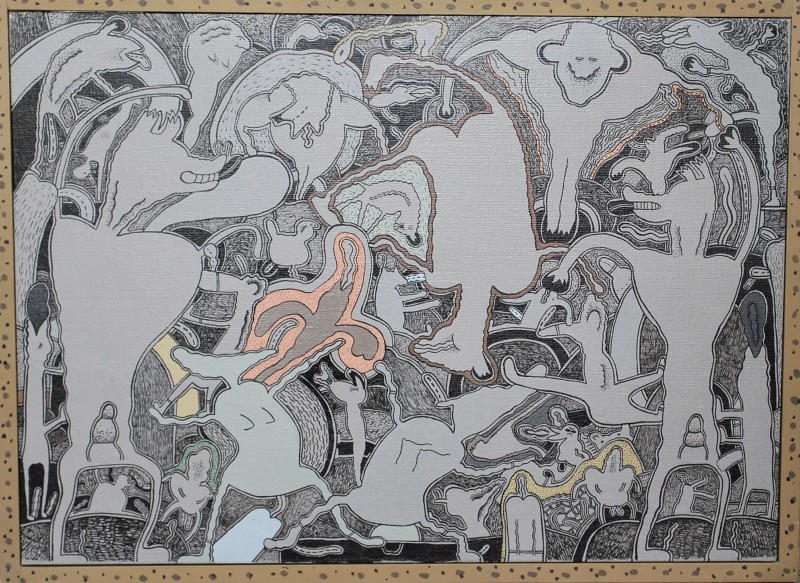
Nilsson, one of the most prominent artists included in George and Natalie’s collection, was one of the original Chicago Imagists and also a member of the Hairy Who, along with her husband, fellow artist Jim Nutt. Although I have included here one of her early acrylic paintings, she is especially well known for her watercolors. In an article about a recent exhibition of hers, John Yau made this remark, which explains George and Natalie’s interest in her: “Her work is weird, funny, creepy, screwball, sexual, unabashed and impolite. On more than one occasion I felt as if I were looking at a bland family who secretly tore wings off insects and ate them for breakfast. The people Nilsson is looking at have no idea how embarrassing they are, which is what gives the work its special twist, but, more importantly, she is unfailingly sympathetic to them.” “Gladys Nilsson’s Portraits of Everywoman,” John Yau, Hyperallergic, November 23, 2014.
Besides the artists discussed above, George and Natalie’s collection includes works by many other artists, among them Robert Arneson, Joan Brown, Viola Frey, Red Grooms, Ronald Kitaj, Sam Messer, Alex Queral, Kyle Staver, Peter Dean, Gina Litherland, Darrel Morris, and Anne Minich. Works by many of these artists, as well as those by Gregory Gillespie, William Beckman, Jane Lund, Anne Kraus, Deborah Kravitz, and Gladys Nilsson, appeared in PAFA’s landmark exhibition Narcissus in the Studio: Artist Portraits and Self-Portraits. Libby Rosof and Roberta Fallon reviewed that exhibition in these pages on December 3, 2010 – see their “Narcissus in the studio at PAFA – embracing life, death and the figure”. PAFA’s wonderful publication that accompanied the exhibition is widely available.
A Final Word
So many of us are collectors of one sort or another. Our collections are reflections of ourselves and they also serve as histories. I have a collection of unusually flat rocks that my children and I gathered over the years from the beaches of Fire Island, where we spent our summers. The rocks are beautiful and marvelous to handle, but the collection has another purpose: it holds cherished memories of time and place. I’m also a collector of odds and ends, from the banal to the ridiculous, which land in the top drawer of my desk. One time, I wrote a piece about each item I found in the drawer. The piece turned out to be mixture of history and free association which essentially told the story of my life.
The art collection of George and Natalie is extraordinary because of their remarkable sensibilities and because it tells the history of a largely overlooked branch of the contemporary art world. I have been enriched and inspired by having had the privilege of experiencing it in person.


